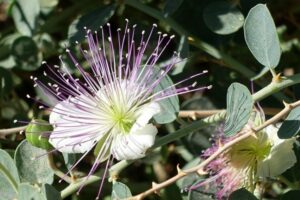Capparis Aegyptia
Egyptian Caper
“Interestingly, one of the floral species on the Shroud that grows in Jerusalem and blooms in the Spring, Capparis aegyptia, provides further corroborating information of the events depicted on the Shroud. Damn, Baruch, and Whanger state: `Capparis aegyptia is also significant as an indicator for the time of the day when its flowering stems were picked. Flowering buds of this species begin to open about midday, opening gradually until fully opened about half an hour before sunset. Flowers seen as images on the Shroud correspond to opening buds at about 3 to 4 o’clock in the afternoon. This was confirmed by a two day experiment with, first, Capparis aegyptia, and later with Capparis spinosa Veillard.’ [Danin, A., et al., “Flora of the Shroud of Turin,” Missouri Botanical Garden Press: St. Louis MO, 1999, p.22] Furthermore, after examining flowers at various stages after they’ve been picked, Whanger concluded that their images most closely matched those that had wilted for twenty-four to thirty-six hours. [Whanger, M. & A., “The Shroud of Turin: An Adventure of Discovery,” Providence House: Franklin TN, 1998, pp. 74-75, 80] This gives an indication of when the flower images might have been formed. This time frame is consistent with the formation of the body images, which occurred within two to three days after the body was placed within the Shroud, due to the lack of decomposition.

Leave a Reply